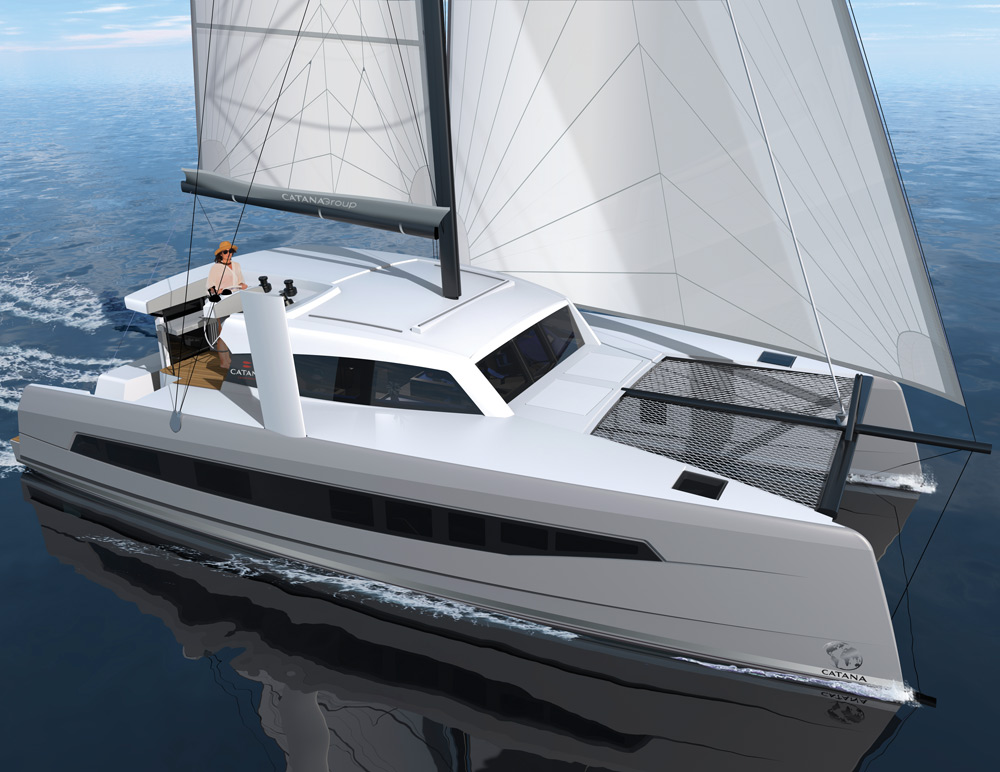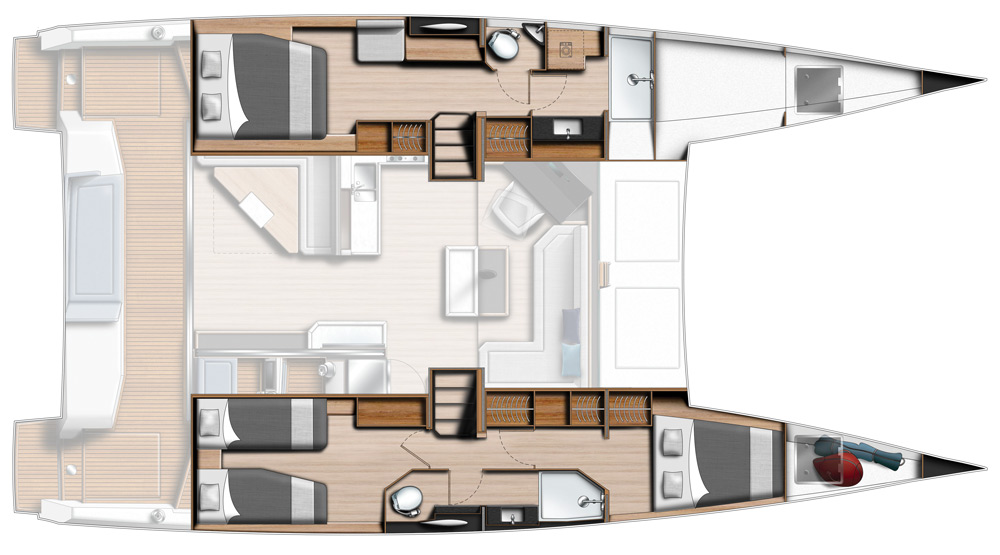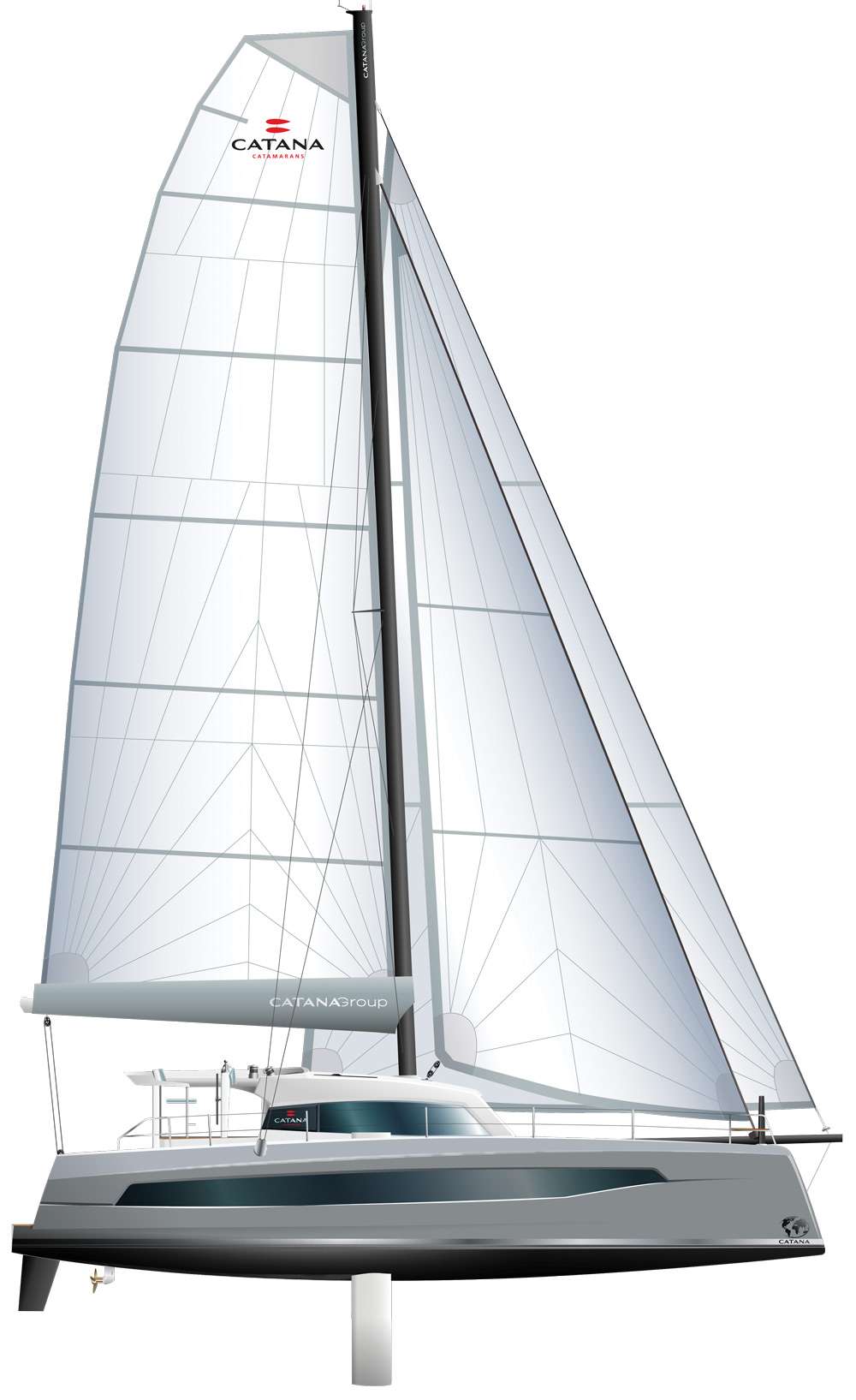Catana OC
This elegant cruising catamaran has speed and sailability
The French catamaran builder Catana started building cruising cats 20 years ago, and at that time, cruising cats were far from mainstream. If you went to the Annapolis boat show back then you might see four cruising cats. It’s very different now. Cats are no longer a novelty but a very well-established category of cruising boats with the popularity still on the rise. Catana puts those 20 years of design and build experience into this new Ocean Series 49-footer (51 feet 8 inches if you add the sprit).

I see nothing unusual in the hull design of this cat. I think I see a chine about 14 inches above the DWL starting about where the cabintrunk starts. I could be wrong. I seldom get very definitive drawings to reveal hull shape details. The bow is the wave piercing type much in fashion today. Not sure how it helps boat speed, but like spoilers on a Toyota, it looks fast. It does look good.
In fact, the entire hull design looks good. The profile shows the max depth of the canoe body well aft to bring the center of buoyancy aft and help prevent the cat from squatting as weight is added. Using the entire boat, I get an L/B of 1.96. If I just use an individual hull I get an L/B of 6.82 and that’s in the “normal” range. So many of the cruising cats have ineffective, low-aspect-ratio fixed keels. They do this to reduce draft, but it sure doesn’t help speed to windward. The Catana uses retractable daggerboards that give a board down draft of 8 feet 2 inches and board up draft of 3 feet 10 inches so you can have the best of both worlds. This cat will do just fine on the wind.
Cat interiors are fun. There is so much square footage to work with. The large area between the hulls is a nice big square space area for a main cabin layout. But the hulls are skinny and do not adapt well to variations on the cat layout theme. The Catana fits this theme. But let’s start with the “nacelle,” as Catana calls it, which is the area between the hulls. Entering from the deck aft there is a large, L-shaped dinette to port. The galley is to port. It’s not as big as some cat galleys, but the nacelle part of this cat is smaller than many of the same areas on other cats. The greater the nacelle area, the heavier the cat. Forward of the galley is the stairs down to the port hull and forward of that is a really nicely spread out nav station. There is an L-shaped settee to starboard. This living space is asymmetrical in that it is cut away aft to starboard so that the “flying bridge” can drop down into that volume. It’s an unusual main deck layout but it works well.
There are several options for the accommodations in the hulls. You can have four staterooms and four heads. You can have four staterooms and two bigger heads. One version has a master stateroom to port with a huge head and lots of stowage in the bow. The starboard hull has two staterooms and one big head. Or, you can have two small heads to starboard. You can even squeeze in a crew cabin with a head to starboard forward of the large owner’s stateroom. I can’t imagine there isn’t one of these layouts that doesn’t tickle your fancy. My favorite would be the large owner’s stateroom to port with the stowage space forward and one big head with two staterooms to starboard.
If you have done any racing recently and found yourself behind a boat with a square-top main I’m sure it did not take you long to understand why the square-top main works so well. There is a lot of effective area up high where the wind is steadier. The head of the main twists off to leeward taking advantage of the wind sheer as the sail gets farther from the friction of the water. And you end up having, in effect, a taller rig as that useless pointy head of the conventional main is eliminated. This main has the new Anomaly Headboard that comes away from the luff car when you drop the main, making furling the sail with that diagonal upper batten much easier and far more cruiser-friendly. The SA/D is 23.1.
If you want to combine comfort with speed in expansive square footage of a catamaran I suggest you take a long look at the Catana.
LOA 51’8”; DWL 49’1”; Beam 25’8”; Displ. 39,000 lb.; Draft boards up 3’8”, boards down 8’2”; Sail area 1,507 sq. ft.; Auxiliary twin 45-hp.; Fuel 211 gal.; Water 211 gal.; L/B 1.96; SA/D 23.1
Catana
66140 Canet en Roussillon, France
Tel: +33 (0) 4 68 80 13 13
email: mathilde.grauet@catanagroup.com



Comments